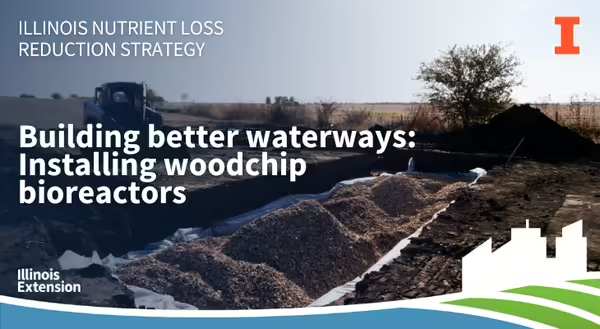
Woodchip bioreactors are one of the edge-of-field land management practices recommended by the Illinois Nutrient Loss Reduction Strategy, NLRS. Bioreactors are installed at the end of a tile drain line to try to capture nutrients, specifically nitrate, that have left the field through the tile drainage before the water is discharged.
A woodchip bioreactor was installed on Brian Corkill’s northern Illinois farm in October 2024 in Henry County. Corkill and contractor David Johnston discussed installing the woodchip bioreactor with Illinois Sustainable Ag Partnership’s manager, Helen VanBeck in episode 68 of the Illinois Nutrient Loss Reduction Podcast. The installation experience on Corkill’s farm highlights the process, benefits, and motivations behind adopting woodchip bioreactors.
What are woodchip bioreactors?
In a woodchip bioreactor, tile-drained water is routed to a woodchip-filled trench located in a grassed buffer where the tile drainage leaves the field. Once the water enters the bioreactor, the denitrification process begins. Bacteria use the carbon from the wood chips as a food source and the incoming nitrate for their respiration. Bioreactors can reduce nitrate levels by 25% in tile-drained water, according to the NLRS, which assesses and recommends research-based nutrient reduction practices.
Installation process
Not every field is well-suited for every conservation practice. Before the process can begin, it must be determined if the field meets the specifications. If the field is suited for a woodchip bioreactor, a design and layout are created to fit the farm’s specific conditions. The bioreactor on Corkill’s farm was designed by the U.S. Department of Agriculture – Natural Resource Conservation Service.
After finalizing the design, construction can begin. Since each field requires a design tailored to its specific needs, it is important to collaborate with an experienced construction company, such as Johnston’s.
Installation is best done in dry conditions to ensure proper sealing of the tile system. Johnston noted this year’s dry fall created ideal conditions for the project.
Considerations
Woodchip bioreactors, like most other agricultural conservation practices, can be expensive. The typical price for a bioreactor installation is around $20,000. The woodchip bioreactor installed on Corkill’s farm was supported through grant funding awarded to University of Illinois Extension and ISAP by One Good Idea and Fishers & Farmers. Resources to locate funding to help support the implementation of agricultural conservation practices can be found on The Financial Incentives Database tool developed by ISAP to share financial payment opportunities that are available. The FIND tool allows farmers to compare programs and select the option that is best suited for their operation.
Benefits and motivations
This is Corkill’s second bioreactor installed on his farm. He has already seen results from his first bioreactor, which was installed four years ago, and has consistently reduced nitrate levels in water samples. Although bioreactors may not treat hundreds of acres, Corkill highlights that even small efforts collectively contribute to reducing nutrient runoff, improving local water quality, and addressing the hypoxic zone in the Gulf of Mexico.
Check out the Illinois Nutrient Loss Reduction Podcast episode 68 to listen to the full interview with Brian Corkill and David Johnston.
About the authors
Rachel Curry is an Agriculture and Agribusiness Educator specializing in agriculture and watershed education, and she is part of the Illinois Extension's Nutrient Loss Reduction Strategy implementation team. She holds a B.A. in Environmental Studies from Knox College and an M.S. in Environmental Science and Soil Science from Iowa State University, with a focus on soil fertility. Her work centers on education and outreach related to the Illinois NLRS, promoting agricultural conservation practices that reduce nutrient loss while enhancing water quality and soil health across Illinois.
Nicole Haverback serves as a Watershed Outreach Associate and is a member of the Illinois Extension's team implementing the Nutrient Loss Reduction Strategy. She holds a B.S. in Agriculture and Rural Policy Studies from Iowa State University. In her role, Nicole coordinates watershed management and planning efforts aimed at reducing nutrient losses in priority areas, offers expertise on best management practices to minimize nutrient loss, and leads outreach initiatives promoting agricultural conservation practices outlined in the Illinois NLRS.
About the blog
At Illinois Extension, we’re working to improve water quality at home and downstream. Every month, our Watershed Outreach Associates will bring you stories highlighting agricultural conservation practices, current research projects and results, and from the field farmer interviews. The Nutrient Loss Reduction blog covers conservation practices recommended by the Illinois Nutrient Loss Reduction Strategy, timely updates, farm safety, and new decision tools to help farmers and producers reduce the nutrients leaving their field. Want to get notified when new blog posts are available? Subscribe at go.illinois.edu/SubscribeINLRS.